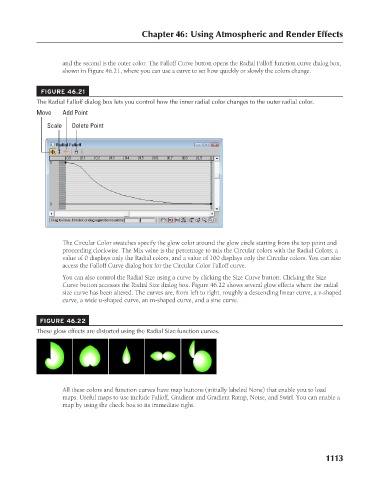Page 1161 - Kitab3DsMax
P. 1161
Chapter 46: Using Atmospheric and Render Effects
shown in Figure 46.21, where you can use a curve to set how quickly or slowly the colors change.
FIGURE 46.21
The Radial Falloff dialog box lets you control how the inner radial color changes to the outer radial color.
Add Point
Move
Delete Point
Scale and the second is the outer color. The Falloff Curve button opens the Radial Falloff function curve dialog box,
The Circular Color swatches specify the glow color around the glow circle starting from the top point and
proceeding clockwise. The Mix value is the percentage to mix the Circular colors with the Radial Colors; a
value of 0 displays only the Radial colors, and a value of 100 displays only the Circular colors. You can also
access the Falloff Curve dialog box for the Circular Color Falloff curve.
You can also control the Radial Size using a curve by clicking the Size Curve button. Clicking the Size
Curve button accesses the Radial Size dialog box. Figure 46.22 shows several glow effects where the radial
size curve has been altered. The curves are, from left to right, roughly a descending linear curve, a v-shaped
curve, a wide u-shaped curve, an m-shaped curve, and a sine curve.
FIGURE 46.22
These glow effects are distorted using the Radial Size function curves.
All these colors and function curves have map buttons (initially labeled None) that enable you to load
maps. Useful maps to use include Falloff, Gradient and Gradient Ramp, Noise, and Swirl. You can enable a
map by using the check box to its immediate right.
1113

